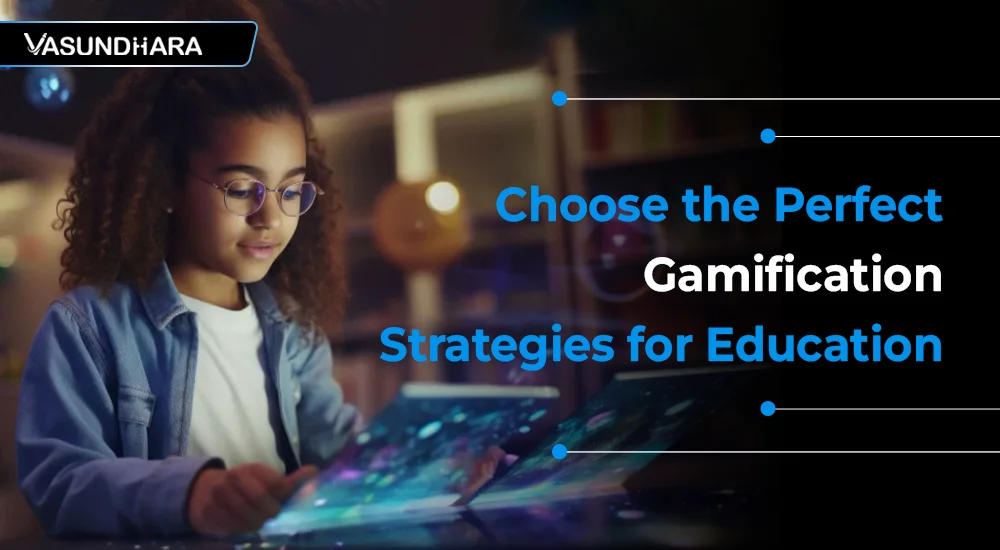Are you an educator constantly seeking innovative ways to engage students and make learning more enjoyable?
You've probably heard about the magic of gamification. If you haven't, you're in for a treat! Gamification is applying game design elements in non-game contexts, like education.
It is critical in modern education, making learning interactive, fun, and memorable. This blog will guide you through the importance of gamification strategies in education, various strategies you can implement, and tips for choosing the perfect one for your classroom.
Stay with us till the end, and feel free to contact us with any inquiries or challenges you currently face. We're here to help!
1. The Need for Gamification in Education
The traditional education system faces several challenges, including low student engagement, lack of motivation, and difficulty understanding complex concepts.
Gamification in education address these challenges by making learning engaging, motivating, and easy to understand.
It provides a sense of achievement, fosters competition, and promotes teamwork. Moreover, it caters to different learning styles, making education inclusive and personalized.
2. Understanding Gamification Strategies
Gamification involves several key elements, such as points, badges, leaderboards, challenges, and storytelling. Let's delve deeper into some popular gamification strategies in education and how they work:
Badges are rewards given to students for achieving specific milestones or completing tasks.
Leaderboards, on the other hand, display students' rankings based on their performance or points earned.
This strategy fosters a sense of achievement and healthy competition among students.
For example, a school in California successfully implemented a badge system, which significantly increased student engagement and performance.
Quests are missions or tasks that students must complete to earn rewards or progress to the next level.
Challenges are activities or problems that students must solve individually or as a team.
This strategy promotes problem-solving, critical thinking, and teamwork.
A university in the UK implemented quests and challenges in their curriculum, which enhanced problem-solving skills and teamwork among students.
Role-playing involves students assuming the roles of characters and acting out scenarios or situations.
This strategy promotes empathy, creativity, and social skills.
A school in Australia implemented role-playing in their history classes, which resulted in a deeper understanding of historical events and improved social skills among students.
Interactive storytelling involves students creating or participating in a narrative.
This strategy promotes creativity, communication, and language skills.
A school in Canada implemented interactive storytelling in their language classes, which resulted in improved language proficiency and communication skills among students.
Educational games are games designed to teach specific concepts or skills.
This strategy promotes active learning, critical thinking, and hand-eye coordination.
A school in the United States implemented educational games in their math classes, which resulted in improved math proficiency and critical thinking skills among students.
3. Choosing the Perfect Gamification Strategy
To choose the perfect gamification strategy for your classroom, consider the following factors:
- Identify Your Learning Objectives
Determine the skills or concepts you want your students to learn. This will help you choose a strategy that aligns with your learning objectives.
Consider your students' age, interests, and learning styles. This will help you choose a strategy that resonates with your students.
Consider the subject matter and complexity of the content. This will help you choose a strategy that complements the content and makes it easier to understand.
- Technology and Platform Constraints
Consider the technology and platforms available to you and your students. This will help you choose a strategy that is feasible and accessible.
Ensure that the gamification strategy you choose aligns with your institution's curriculum and educational standards.
This will ensure that the game is engaging, educationally sound, and beneficial to the students.
- Consider Time Constraints
Consider the amount of time you and your students have.
Some gamification strategies require more preparation and implementation time than others.
Choose a strategy that fits into your and your students’ schedules without causing undue stress.
Consider the resources you have at your disposal, including financial resources, technical support, and materials. Some gamification strategies may require more resources than others.
Consider whether the gamification strategy can be scaled up or down depending on your class size. Some strategies work well for small groups but may be less effective for larger classes.
- Reflect on Your Teaching Style
Your teaching style is crucial in determining the success of the gamification strategy. Choose a strategy that complements your teaching style and enhances your strengths as an educator.
4. Implementing Gamification in Your Classroom
Once you’ve chosen a suitable gamification strategy, follow these steps to implement it in your classroom:
Define the rules, objectives, and rewards of the game.
Create a storyboard or a blueprint of the game. This will be a visual representation of the game from start to finish.
Determine the learning objectives. What do you want your students to learn from this game?
Decide on the game dynamics (competition, collaboration, points, levels, challenges, etc.)
Develop the game using appropriate tools and platforms. You can use online platforms like Kahoot! or Quizlet or develop your game using Unity or Scratch.
Create engaging and interactive content that will keep your students interested.
Incorporate elements like quizzes, puzzles, and challenges that align with the learning objectives.
Test the game to ensure it works appropriately and aligns with your learning objectives.
Play the game yourself or ask a colleague to play it and provide feedback.
Make any necessary adjustments based on the feedback received.
Implement the game in your classroom. Provide clear instructions to your students and monitor their progress.
Set up the game and ensure all the technical aspects work correctly.
Brief your students about the game, its rules, and objectives.
Gather feedback from your students and make necessary adjustments to improve the game.
5. Measuring the Impact of Gamification on Learning
To measure the impact of gamification on learning, consider the following key performance indicators (KPIs):
Observe students' interaction and participation during the game to assess their engagement level.
Look for signs of active participation, meaningful interactions, and sustained interest throughout the game.
Assess students' eagerness to participate before the game, their drive to succeed during the game, and their sense of accomplishment after the game to determine if it fostered motivation.
Evaluate students' understanding and application of the concepts or skills taught during the game and assess their knowledge retention after the game to determine if it enhances learning outcomes.
Collect feedback from students and other teachers to identify areas for improvement and make necessary adjustments.
Encourage students to reflect on their experience and learn from the game to consolidate their understanding and develop self-awareness.
Ensure the game complements the overall curriculum and learning objectives, and make connections between the game and other topics or subjects being taught.
Incorporate formative and summative assessments, using various methods such as quizzes, presentations, and peer assessments, to comprehensively evaluate students' learning.
Conclusion
Gamification is a powerful tool that can transform your classroom and enhance learning outcomes.
By implementing the right gamification in education and continuously assessing their impact, you can create an engaging, motivating, and inclusive learning environment.
Remember to consider your learning objectives, audience, content, and technology constraints when choosing a gamification strategy.
Are you facing any challenges or have inquiries about implementing gamification in your classroom? We’re here to help! Happy gaming!
Are you an educator who has successfully implemented gamification in your classroom?
We would love to hear your success stories and tips! If you’re looking to implement gamification and need guidance or support, feel free to contact us or request a quote for your specific development requirements. We’re here to help!




